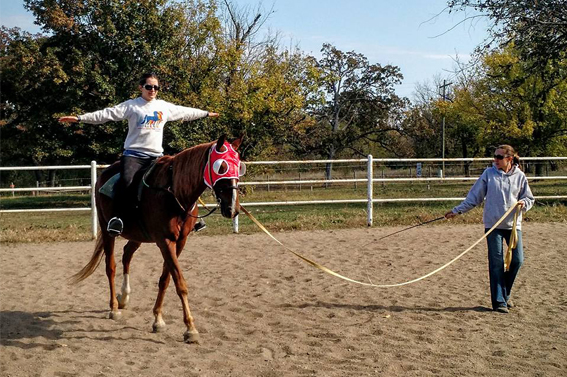- Details
- Written by: Bonnie Hilton
- Category: Training
 I didn’t start learning how to ride on the end of a longe line. I wish I had because I would have had a more solid development and understanding of the independent seat and the nuances, the subtleties needed for the correct application of the aids, especially later in life when I started the sometimes arduous task of retraining.
I didn’t start learning how to ride on the end of a longe line. I wish I had because I would have had a more solid development and understanding of the independent seat and the nuances, the subtleties needed for the correct application of the aids, especially later in life when I started the sometimes arduous task of retraining.
As Alois Podhajsky stated in The Complete Training of the Horse and Rider, “Even when presenting a fully trained horse, a rider must have considerable knowledge and experience. How much more he will require to train an untrained horse and still more to retrain a badly trained one.” (Please note that I will be quoting from this same classic work by Podhajsky in other areas of this article.)
If I had started my riding career on the longe I would not have spent years struggling, as so many riders continue to do, to learn how to produce, allow and actually ride forward, instead of trying to make forward happen by force. I lacked as a rider the training as, “the physical and mental proficiency to be able to follow them with skill and power, and be able to resist them if necessary.” As a youngster I developed the seat of the pants style of riding, a strong foundation in part but far from complete in the skill aspect. It was a foundation that had to be broken down in order to build anew in 1970 and it started when I was first put on the longe in Vermont prior to going to England and then a decade later in Massachusetts on the longe when I started studying body awareness.
- Details
- Written by: Bonnie Hilton
- Category: Training
As each and every one of us is different due to our upbringing, body type, talents and limitations, so are our horses. We can lump individuals into categories due to conformation, breeding and known specifics of that breed, but individualism still exists. Take for instance the categorization of specific breeds into terms such as hot, cold or warm. What category would best describe your equine or do they fall into more than one category? I have worked with some very hot cold bloods and conversely some hot bloods that were more like cold bloods. I presently have a warmblood in work that can exhibit both traits of being a hot blood and a cold blood during a single training session. How do you start to assess what your horse may need in warm-up to enhance its performance and actually maintain it? What daily considerations have to be made? Are there variables that exist?
- Details
- Written by: Bonnie Hilton
- Category: Training
Reader beware, this will be one of those “soapbox” type articles. Now for those younger readers who have no idea what soapbox is referring to, I’ll explain. In years gone by, when we didn’t have e-mail, Facebook, Twitter and instant access, if you wanted to make your opinion known to a street audience you would find an improvised platform, something like a box or crate used to deliver soap, and stand on it while you were giving your impassioned speech on the subject you felt needed to be brought forward. So, I am on my virtual soapbox and will be voicing my opinion in print over a common problem, a question that must be answered honestly, that an equine trainer may face from time to time, especially if they decide to work as a freelance, traveling to private and public facilities to teach and train. Is this horse your pet or your performance equine?



